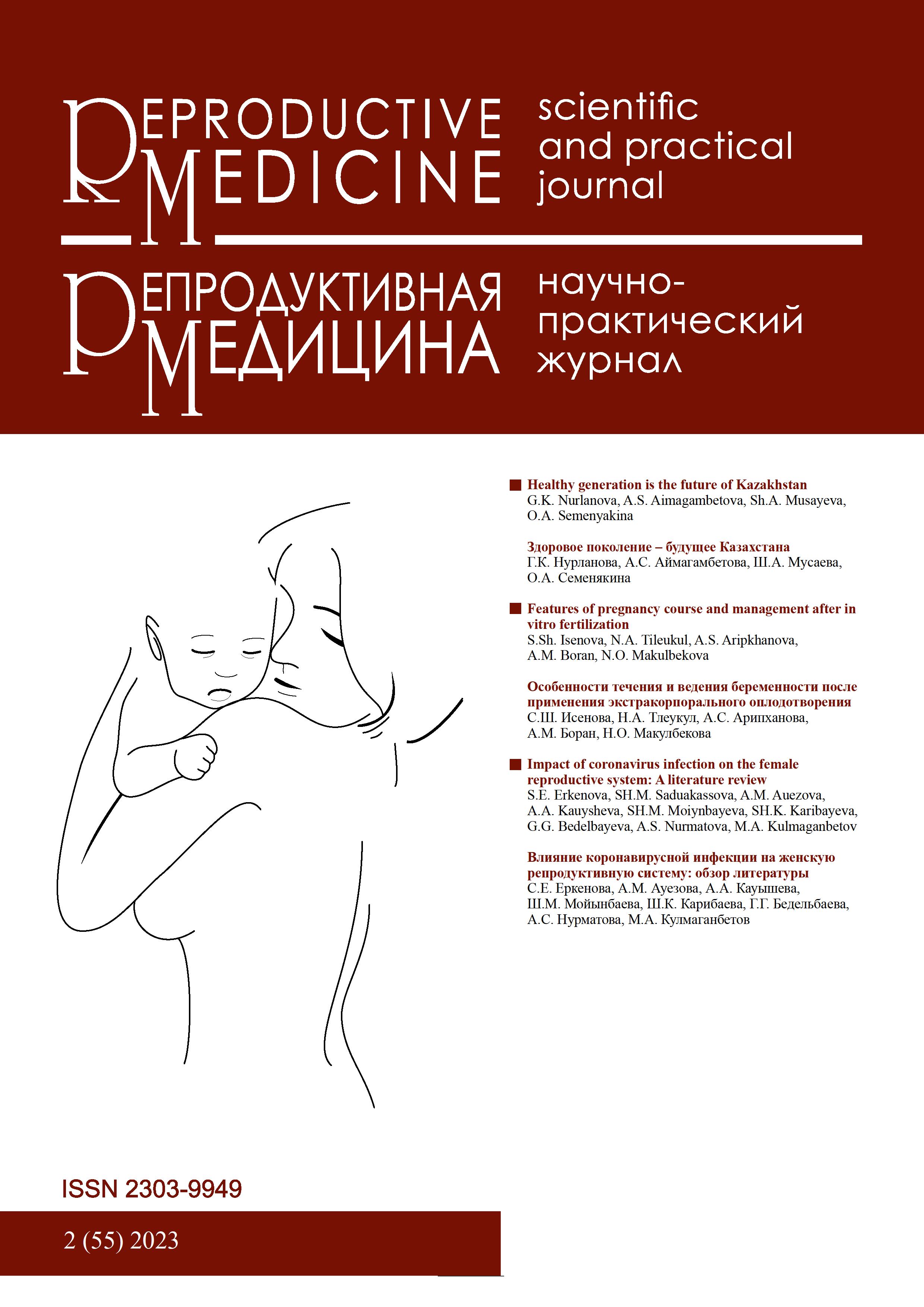Pathology of the fetus and placenta after IVF: A retrospective study
DOI:
https://doi.org/10.37800/RM.2.2023.53-59Keywords:
IVF, placenta, placenta previa, congenital malformations, retrochorial hematoma, premature detachment of the normally located placenta, fetal chromosomal abnormalitiesAbstract
Relevance: To date, it has been convincingly shown that pregnancy after in vitro fertilization (IVF) belongs to the high-risk group. In pregnancy after IVF and the embryo transfer, the frequency of fetoplacental insufficiency is observed in more than 70% of cases, fetal growth retardation occurs in 18-30% of cases, and placenta previa – in 2% of pregnancies conceived with assisted reproductive technologies (ART). The frequency of fetal malformations after ART can reach 4,4%, twice as high as in the general population (2,05%); most are associated with congenital heart defects and central nervous and musculoskeletal system malformations. Chromosomal abnormalities and epigenetic defects are significantly more common.
The study aimed to determine the frequency of fetal and placental pathology development after using IVF.
Materials and methods: Conduct a literature review over the past five years on evidence bases: PubMed, Medline, Cochrane Library, LILACS, WHO, Scopus and Web of Science, and Google Scholar to find peer-reviewed publications.
The study was conducted at PERSONA International Clinical Center for Reproductology (Almaty, Kazakhstan). A retrospective analysis included 320 cards of pregnant women registered for pregnancy from 9-10 weeks in the Persona ICCR from 2018 to 2022. The participants were divided into two groups: the IVF group included pregnant women after IVF (n=162), and the comparison group included women with spontaneous pregnancy (n=158).
Results: Fetal congenital malformations were more common after IVF (11.1% vs. 5.7%); most were associated with congenital heart defects and malformations of the urinary and musculoskeletal systems. A high risk of chromosomal pathology (6.7% vs. 3.1%), low placentation (19.7% vs. 12%), retrochorial hematoma (26% vs. 11%), and placenta abruption were significantly more common in the group after IVF.
Conclusion: Considering the obtained results, one can think about an increased risk of chorionic and placenta previa, retrochorial hematoma, premature detachment of a normally located placenta, chromosomal abnormalities, and congenital malformations in patients after IVF. The high frequency of fetus and placenta pathologies in patients after ART urges the development of clinical guidelines for managing pregnancy in the antenatal period to reduce the frequency of obstetric and perinatal complications.
References
Клиническая практика в репродуктивной медицине: руководство для врачей / под ред. В.Н. Локшина, Т.М. Джусубалиевой. – Алматы: ТОО «МедМедиа Казахстан», 2015. – 464 с. [Klinicheskaya praktika v reproduktivnoj medicine: rukovodstvo dlya vrachej / pod red. V.N. Lokshina, T.M. Dzhusubalievoj. – Almaty: TOO «MedMedia Kazaxstan», 2015. – 464 s.] ISBN: 978-601-80151-6-8. https://www.elibrary.ru/item.asp?id=29788885
Исенова С.Ш., Бодыков Г.Ж., Ким В.Д., Каргабаева Ж.А., Казыбаева А.С., Кабыл Б.К. Анализ особенностей течения беременности и родов у пациенток с бесплодием в анамнезе после применения программ вспомагательных репродуктивных технологий (ВРТ) // Репродуктивная медицина. – 2019. – №3(40). – С. 45-48 [Isenova S.Sh., Bodykov G.Zh., Kim V.D., Kargabaeva Zh.A., Kazybaeva A.S., Kabyl B.K. Analiz osobennostei techeniya beremennosti i rodov u pacientok s besplodiem v anamneze posle primeneniya programm vspomagatelnih reproduktivnih tehnologii (VRT) // Reproduktivnaya medicina. – 2019. – №3(40). – S. 45-48 (in Russ.)]. https://repromed.kz/index.php/journal/article/view/111
Локшин В.Н., Карибаева Ш.К., Омар М.Д. Доступность лечения бесплодия с помощью ВРТ в различных социально-экономических группах. Обзор литературы // Репродуктивная медицина. – 2019. – №3(40). – С. 8-10. [Lokshin V.N., Karibayeva Sh.K., Omar M.D. Dostupnost’ lecheniya besplodiya s pomoschyu VRT v razlichnih socialno-ekonomicheskih gruppah. Obzor literaturi // Reproduktivnaya medicina. – 2019. – №3(40). – С. 8-10 (in Russ.)]. https://repromed.kz/index.php/journal/article/view/104
Макаров И.О. Ведение беременности после экстракорпорального оплодотворения (Клиническая лекция) // Гинекология. – 2010. – Т. 2. – С. 21-26 [Makarov I.O. Vedenie beremennosti posle ekstrakorporalnogo oplodotvoreniya (Klinicheskaya lekciya) //I.O. Makarov // Ginekologiya. – 2010. – Т. 2. – S. 21-26 (in Russ.)]. https://omnidoctor.ru/upload/iblock/00d/00dba58cb6fc3da5b36999b433cb68b6.pdf
Иакашвили С.Н., Самчук П.М. Особенности течения и исход одноплодной беременности, наступившей после экстракорпорального оплодотворения и переноса эмбриона, в зависимости от фактора бесплодия // Современные проблемы науки и образования. – 2017. – № 3 [Iakashvili S.N., Samchuk P.M. Osobennosti techeniya i ishod odnoplodnoi beremennosti, nastupivshei posle ekstrakorporalnogo oplodotvoreniya i perenosa embriona v zavisimosti ot faktora besplodiya // Sovremennie problemi nauki i obrazovaniya. – 2017. – № 3.] https://doi.org/10.17513/spno.26486
Кулаков В.И., Орджоникидзе Н.В., Тютюнник В.Л. Плацентарная недостаточность и инфекция: Руководство для врачей. – М.: Гайнуллин, 2004. – 496 с. [Kulakov V.I., Ordzhonikidze N.V., Tyutyunnik V.L. Placentarnaya nedostatochnost’ i infekciya: Rukovodstvo dlya vrachej. – M.: Gajnullin, 2004. – 496 s. (in Russ.)].
Tikkanen M. Placental abruption: epidemiology, risk factors and consequences // Acta Obstet. Gynecol. Scand. – 2011. – Vol. 90(2). – P. 140-149. https://doi.org/10.1111/j.1600-0412.2010.01030.x
Brăila A.D., Gluhovschi A., Neacşu A., Lungulescu C.V., Brăila M., Vîrcan E.L., Cotoi B.V., Gogănău A.M. Placental abruption: etiopathogenic aspects, diagnostic and therapeutic implications // Rom. J. Morphol. Embryol. – 2018. – Vol. 59(1). – P. 187-195. https://pubmed.ncbi.nlm.nih.gov/29940627/
Sheng Q.J., Wang Y.M., Wang B.Y., Shuai W., He X.Y. Triplet pregnancy with hydatidiform mole: A report of two cases with literature review // J. Obstet. Gynaecol. Res. – 2022. – Vol. 48(6). – P. 1458-1465. https://doi.org/10.1111/jog.15243
Alpay V., Kaymak D., Erenel H., Cepni I., Madazli R. Complete Hydatidiform Mole and Co-Existing Live Fetus after Intracytoplasmic Sperm Injection: A Case Report and Literature Review // Fetal Pediatr. Pathol. – 2021. – Vol. 40(5). – P. 493-500. https://doi.org/10.1080/15513815.2019.1710790
Nickkho-Amiry M., Horne G., Akhtar M., Mathur R., Brison D.R. Hydatidiform molar pregnancy following assisted reproduction // J. Assist. Reprod. Genet. – 2019. – Vol. 36(4). – P. 667-671. https://doi.org/10.1007/s10815-018-1389-9
Matorras R., Zallo A., Hernandez-Pailos R., Ferrando M., Quintana F., Remohi J., Malaina I., Laínz L., Exposito A. Cervical pregnancy in assisted reproduction: an analysis of risk factors in 91,067 ongoing pregnancies // Reprod. Biomed. Online. – 2020. – Vol. 40(3). – P. 355-361. https://doi.org/10.1016/j.rbmo.2019.12.011
Romundstad L.B., Romundstad P.R., Sunde A., von Düring V., Skjærven R., Vatten L.J. Increased risk of placenta previa in pregnancies following IVF/ICSI; a comparison of ART and non-ART pregnancies in the same mother // Hum. Reprod. – 2006. – Vol. 21 (9). – P. 2353-2358. https://doi.org/10.1093/humrep/del153
Jauniaux E., Moffett A., Burton G.J. Placental Implantation Disorders // Obstet. Gynecol. Clin. North Am. – 2020. – Vol. 47(1). – P. 117-132. https://doi.org/10.1016/j.ogc.2019.10.002
Kong F., Fu Y., Shi H., Li R., Zhao Y., Wang Y., Qiao J. Placental Abnormalities and Placenta-Related Complications Following In-Vitro Fertilization: Based on National Hospitalized Data in China // Front. Endocrinol. – 2022. – Vol. 13. – Art. ID: 924070. https://doi.org/10.3389/fendo.2022.924070
Matsuzaki S., Ueda Y., Matsuzaki S., Nagase Y., Kakuda M., Lee M., Maeda M., Kurahashi H., Hayashida H., Hisa T., Mabuchi S., Kamiura S. Assisted Reproductive Technique and Abnormal Cord Insertion: A Systematic Review and Meta-Analysis // Biomedicines. – 2022. – Vol. 10(7). – Art. ID: 1722. https://doi.org/10.3390/biomedicines10071722
Zheng Z., Chen L., Yang T., Yu H., Wang H., Qin J. Multiple pregnancies achieved with IVF/ICSI and risk of specific congenital malformations: a meta-analysis of cohort studies // Reprod. Biomed. Online. – 2018. – Vol. 36(4). – P. 472-482. https://doi.org/10.1016/j.rbmo.2018.01.009
Francois L., Kugler L., Santolaya J.L., Faro R., Di Stefano V., Merjanian L., Santolaya-Forgas J. Screening for Down syndrome in dichorionic twin pregnancies conceived by in vitro fertilization (IVF): a clinical pilot study to confirm the laboratory methods // J. Assist. Reprod. Genet. – 2014. – Vol. 31(1). – P. 125-128. https://doi.org/10.1007/s10815-013-0130-y
Sánchez-Pavón E., Mendoza H., García-Ferreyra J. Trisomy 21 and Assisted Reproductive Technologies: A review // JBRA Assist. Reprod. – 2022. – Vol. 26(1). – P. 129-141. https://doi.org/10.5935/1518-0557.20210047
Heisey A.S., Bell E.M., Herdt-Losavio M.L., Druschel C. Surveillance of congenital malformations in infants conceived through assisted reproductive technology or other fertility treatments // Birth Defects Res. Clin. Mol. Teratol. – 2015. – Vol. 103(2). – P. 119-126. https://doi.org/10.1002/bdra.23355
Vermey B.G., Buchanan A., Chambers G.M., Kolibianakis E.M., Bosdou J., Chapman M.G., Venetis C.A. Are singleton pregnancies after assisted reproduction technology (ART) associated with a higher risk of placental anomalies compared with non-ART singleton pregnancies? A systematic review and meta-analysis // BJOG. – 2019. – Vol. 126(2). – P. 209-218. https://doi.org/10.1111/1471-0528.15227
Ковалева Ю.В. Ретрохориальная гематома. Вопросы этиопатогенеза, диагностики и терапии // Журнал акушерства и женских болезней. – 2013. – Т. 62. – №4. – C. 37-47 [Kovaleva Yu.V. Retroxorial’naya gematoma. Voprosy e’tiopatogeneza, diagnostiki i terapii // Zhurnal akusherstva i zhenskix boleznej. – 2013. – T. 62. – №4. – C. 37-47 (in Russ.)]. https://doi.org/10.17816/JOWD62437-47
Spencer K. Screening for Down syndrome // Scand. J. Clin. Lab. Invest. Suppl. – 2014. – Vol. 244. – P. 41-47. https://doi.org/10.3109/00365513.2014.936680
Manegold-Brauer G., Maymon R., Shor S, Cuckle H, Gembruch U, Geipel A. Down’s syndrome screening at 11-14 weeks’ gestation using prenasal thickness and nasal bone length // Arch. Gynecol. Obstet. – 2019. – Vol. 299(4). – P. 939-945. https://doi.org/10.1007/s00404-019-05083-2
Downloads
Published
How to Cite
Issue
Section
License
The articles published in this Journal are licensed under the CC BY-NC-ND 4.0 (Creative Commons Attribution – Non-Commercial – No Derivatives 4.0 International) license, which provides for their non-commercial use only. Under this license, users have the right to copy and distribute the material in copyright but are not permitted to modify or use it for commercial purposes. Full details on the licensing are available at https://creativecommons.org/licenses/by-nc-nd/4.0/.





